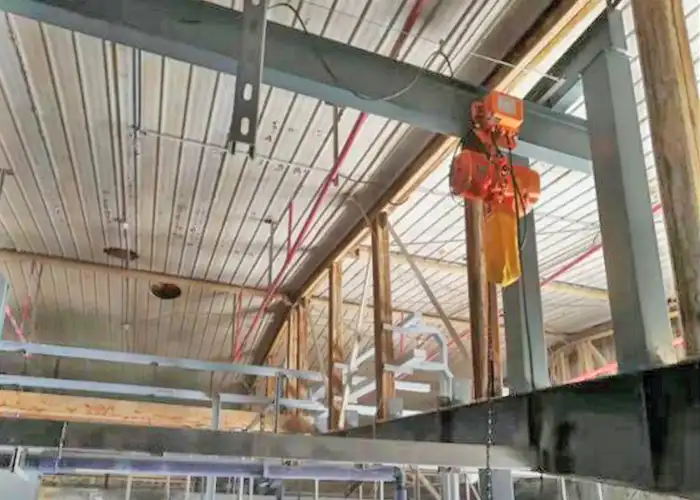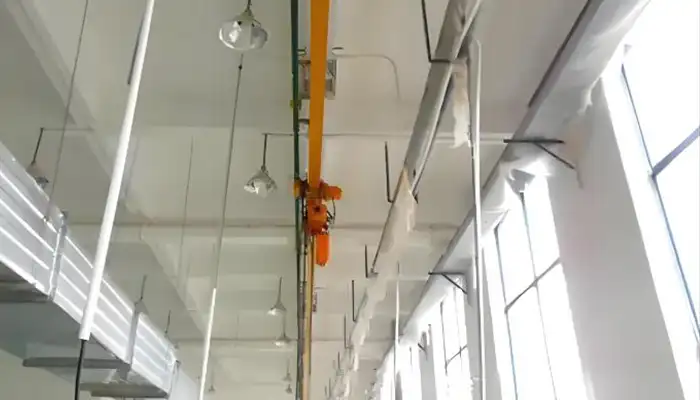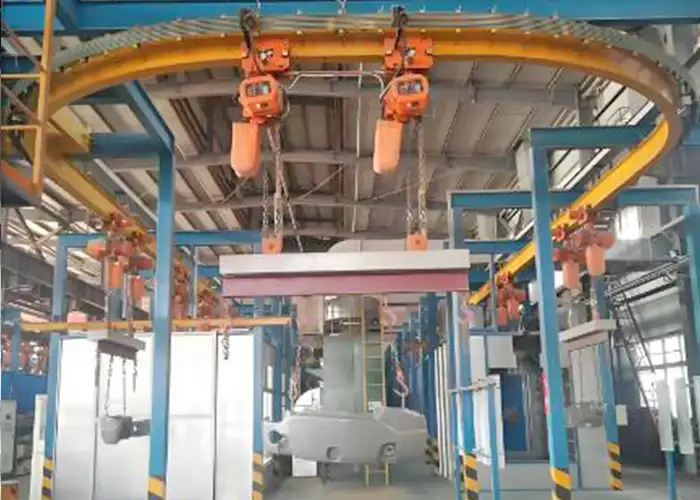Overhead Ceiling-Mounted & Floor-Mounted Monorail Cranes
Overhead Ceiling-Mounted & Floor-Mounted Monorail Cranes
Choosing Between Overhead Ceiling-Mounted and Floor-Mounted Monorail Cranes: A Comprehensive Guide
Monorail cranes are indispensable tools in industrial settings, offering efficient lifting and transport solutions for various loads. They are designed to streamline operations, enhance productivity, and ensure safety in diverse industries such as manufacturing, logistics, and construction.
Why Mounting Type Matters
When selecting a monorail crane, one of the critical decisions is choosing between ceiling-mounted and floor-mounted configurations. This choice significantly impacts operational efficiency, space utilization, and overall effectiveness within your facility.
Ceiling-Mounted Monorail Cranes
Ceiling-mounted monorail cranes are strategically installed overhead, utilizing the vertical space of your facility. They are ideal for maximizing floor space, which is crucial in environments where every square foot counts. By suspending the crane from the ceiling, these systems offer unobstructed movement along designated tracks, covering large areas efficiently. This setup minimizes interference with ground-level activities, optimizing workflow and enhancing operational flexibility.
Installing ceiling-mounted monorail cranes involves careful consideration of structural requirements and integration with existing infrastructure. Facilities need adequate ceiling height and structural support to accommodate the crane's weight and operational loads. However, once installed, these cranes provide seamless movement and accessibility, making them suitable for industries requiring frequent and extensive material handling tasks.
Floor-Mounted Monorail Cranes
Contrastingly, floor-mounted monorail cranes are anchored to the ground, offering flexibility in placement and accessibility. These cranes are ideal for facilities with specific layout requirements or where ceiling height limitations restrict the use of overhead systems. Floor-mounted configurations allow for easier installation and maintenance, as they do not rely on overhead supports.
Choosing a floor-mounted monorail crane involves considerations such as floor load capacity and layout planning. These systems are advantageous in environments where frequent reconfiguration of the workspace is necessary or where additional support structures may not be feasible. They provide direct access to loads from ground level, facilitating efficient material handling and reducing turnaround times in operations.
The decision between ceiling-mounted and floor-mounted monorail cranes hinges on various factors, including facility layout, operational needs, and budget considerations. Each type offers distinct advantages in terms of space utilization, operational efficiency, and installation requirements. By understanding these differences and aligning them with your specific industry requirements, you can make an informed choice that enhances productivity and safety within your workspace.
For more detailed guidance on selecting the right monorail crane for your needs, consult with industry experts and explore tailored solutions that optimize your operational capabilities effectively.
Basics of Monorail Cranes
Monorail cranes are essential tools in industrial environments, designed for efficient material handling and lifting operations. They consist of a single beam track that supports a trolley and hoist mechanism, allowing for precise movement of loads along a fixed path within a facility.
Definition and Basic Components
A monorail crane typically comprises:
- Single Beam Track: A track system mounted either on the ceiling or floor, providing a designated path for the trolley and hoist.
- Trolley: A wheeled mechanism that travels along the track, carrying the load.
- Hoist: The lifting mechanism attached to the trolley, used to raise and lower loads.
- Controls: Operating panels or pendant controls for managing crane movements and load handling.
These components work together to enable safe and efficient transport of materials across different points within a facility. Monorail cranes are adaptable to various load capacities and operational requirements, making them versatile solutions in industries such as manufacturing, warehousing, and assembly.
Advantages and Typical Use Cases
The advantages of monorail cranes include:
- Space Efficiency: They optimize floor space by utilizing overhead or floor-mounted tracks, freeing up ground-level areas for other operations.
- Versatility: Monorail cranes can be customized with different hoist capacities and track lengths to accommodate specific handling needs.
- Cost-Effectiveness: Compared to complex overhead crane systems, monorail cranes offer a more economical solution for moving loads along a fixed path.
Typical use cases for monorail cranes include:
- Assembly Lines: Facilitating the movement of components and subassemblies during manufacturing processes.
- Material Handling: Transporting raw materials or finished products between production areas or storage locations.
- Maintenance Workshops: Supporting equipment handling and maintenance tasks with precision and efficiency.
In summary, monorail cranes are integral to enhancing operational efficiency and workflow within industrial settings. Their straightforward design and flexible configurations make them indispensable tools for optimizing material handling processes and improving overall productivity.
Ceiling-Mounted Monorail Cranes
Ceiling-mounted monorail cranes are pivotal in industrial settings where maximizing floor space and enhancing material handling efficiency are paramount. These systems are characterized by their overhead installation, utilizing the vertical space of facilities to optimize operational workflows.
Description of Ceiling-Mounted Systems
Ceiling-mounted monorail cranes feature a single beam track that is securely attached to the ceiling structure of a building. This configuration allows the crane's trolley and hoist to move freely along the track, covering designated areas with ease. The track is typically supported by robust ceiling supports or runway beams, ensuring stability and safe operation.
Benefits
- Maximizing Floor Space: By suspending the crane from the ceiling, floor-mounted obstacles are minimized, enabling unobstructed movement of goods and equipment below. This layout is ideal for facilities with limited ground-level space, optimizing overall operational efficiency.
- Ease of Movement and Coverage: Ceiling-mounted monorail cranes provide extensive coverage along their designated path. This setup facilitates efficient material handling tasks, allowing operators to maneuver loads precisely from one workstation to another without ground-level congestion.
Considerations for Installation
- Structural Requirements: Installing a ceiling-mounted monorail crane necessitates a robust ceiling structure capable of supporting the crane's weight and operational loads. Structural engineers typically assess the building's load-bearing capacity to ensure safe installation and operation.
- Integration with Existing Infrastructure: Before installation, compatibility with existing building infrastructure must be evaluated. Factors such as ceiling height, obstructions, and electrical connections for the crane's operation need careful consideration to ensure seamless integration without disrupting ongoing operations.
Ideal Industries and Applications
Ceiling-mounted monorail cranes find extensive use across various industries, including:
- Manufacturing: Supporting assembly lines by transporting components and products between workstations efficiently.
- Warehousing: Facilitating the movement of goods within storage facilities, optimizing inventory management and order fulfillment processes.
- Automotive: Handling vehicle components during assembly and manufacturing processes, ensuring streamlined production operations.
In conclusion, ceiling-mounted monorail cranes offer significant advantages in maximizing floor space, enhancing operational flexibility, and optimizing material handling efficiency. Their overhead installation makes them well-suited for industries where space utilization and workflow optimization are critical factors in achieving operational excellence.
Floor-Mounted Monorail Cranes
Floor-mounted monorail cranes offer versatile solutions for industrial environments seeking efficient material handling capabilities while maintaining flexibility in installation and maintenance accessibility.

Floor-mounted monorail cranes are anchored directly to the ground, providing stability and ease of installation without requiring overhead support structures. These cranes typically feature a single beam track mounted at ground level, supporting a trolley and hoist mechanism that moves along the designated path.
Advantages
- Flexibility in Installation: Unlike ceiling-mounted cranes, floor-mounted configurations do not rely on existing ceiling structures. This allows for more flexibility in placement within a facility, accommodating specific layout requirements or areas where overhead space is limited.
- Accessibility for Maintenance: Ground-level installation simplifies maintenance and servicing tasks. Technicians can easily access the crane components, including the track, trolley, and hoist, for routine inspections, repairs, or adjustments without the need for specialized equipment or extensive downtime.
Installation Considerations
- Floor Load Capacity: Before installation, it's crucial to evaluate the floor's load-bearing capacity to ensure it can support the crane's weight and operational loads safely. Structural engineers may need to reinforce the floor or select suitable mounting points to distribute the load effectively.
- Space Utilization and Layout Planning: Floor-mounted monorail cranes require adequate floor space for the installation of the track system and maneuverability of the trolley. Proper layout planning ensures optimal utilization of space while minimizing obstruction to other operational areas or workflows.
Suitable Industries and Applications
Floor-mounted monorail cranes are well-suited for various industries and applications, including:
- Heavy Manufacturing: Handling large components or equipment during assembly processes.
- Steel Fabrication: Transporting raw materials and finished products across fabrication workshops.
- Maintenance Facilities: Supporting equipment handling and maintenance tasks with precision and accessibility.
These cranes provide efficient material handling solutions where flexibility, accessibility, and straightforward installation are essential considerations in enhancing operational efficiency and workflow optimization.
Comparative Analysis of Ceiling-Mounted and Floor-Mounted Monorail Cranes
When choosing between ceiling-mounted and floor-mounted monorail cranes, several key factors must be considered to ensure optimal performance, cost-effectiveness, and safety in industrial applications.
Performance Comparison
Load Capacity and Lifting Heights:
- Ceiling-Mounted Cranes: Typically offer higher load capacities and greater lifting heights compared to floor-mounted cranes. This is due to their overhead installation, which allows for efficient utilization of vertical space and the ability to handle heavier loads over longer distances.
- Floor-Mounted Cranes: While generally more limited in load capacity and lifting height compared to ceiling-mounted cranes, they are versatile for handling moderate to heavy loads within specific operational areas on the ground.
Operational Efficiency:
- Ceiling-Mounted Cranes: Provide enhanced operational efficiency by maximizing floor space and enabling unobstructed movement of materials across the facility. They are ideal for continuous material handling tasks, reducing turnaround times and improving workflow efficiency.
- Floor-Mounted Cranes: Offer flexibility in installation and can be strategically placed to optimize workflow within specific workstations or areas. They are advantageous for applications requiring frequent reconfiguration or localized material handling.
Cost Considerations
Initial Investment:
- Ceiling-Mounted Cranes: Typically involve higher initial costs due to structural requirements for overhead installation and ceiling support systems. However, they may offer long-term cost savings through improved operational efficiency and space utilization.
- Floor-Mounted Cranes: Generally have lower initial costs compared to ceiling-mounted cranes, as they do not require extensive structural modifications or overhead support. Installation expenses are primarily related to floor preparation and track assembly.
Maintenance and Operational Costs:
- Ceiling-Mounted Cranes: May incur higher maintenance costs related to overhead components and periodic inspections of ceiling supports and track systems. Operational costs include electricity consumption for crane operation and potential downtime for maintenance activities.
- Floor-Mounted Cranes: Often have lower maintenance costs, as components are easily accessible for routine inspections and repairs. Operational costs primarily involve electricity usage and periodic lubrication of track systems.
Safety Features and Considerations
Operator Safety:
- Ceiling-Mounted Cranes: Require strict adherence to safety protocols due to overhead movement and potential hazards associated with suspended loads. Safety features such as limit switches, emergency stop buttons, and operator training are critical to mitigating risks.
- Floor-Mounted Cranes: Offer enhanced visibility and easier access for operators, contributing to improved safety during load handling. Safety features may include anti-collision sensors, load limiters, and ergonomic controls to minimize operator fatigue and injury.
Workplace Ergonomics:
- Ceiling-Mounted Cranes: Enhance workplace ergonomics by reducing manual handling and repetitive lifting tasks. Operators can control loads from a distance, optimizing posture and minimizing strain during operations.
- Floor-Mounted Cranes: Support ergonomic work practices by facilitating precise load positioning and adjustment at ground level. They are beneficial for tasks requiring frequent load manipulation or assembly operations that require close proximity to the work surface.
In conclusion, the choice between ceiling-mounted and floor-mounted monorail cranes should align with specific operational needs, facility constraints, and budget considerations. Each option offers distinct advantages in terms of performance, cost-efficiency, and safety features, ensuring tailored solutions that optimize material handling processes and enhance overall productivity in industrial environments.
Factors to Consider When Choosing Between Ceiling-Mounted and Floor-Mounted Monorail Cranes
Choosing the right monorail crane—whether ceiling-mounted or floor-mounted—requires careful consideration of project-specific requirements and operational considerations to ensure optimal performance and efficiency within your industrial environment.
Project-Specific Requirements
Load Capacity and Frequency of Use:
- Ceiling-Mounted Cranes: Ideal for handling heavy loads and frequent material handling tasks over extended distances. They offer high load capacities and can operate continuously without obstructing ground-level workflows.
- Floor-Mounted Cranes: Suitable for moderate to heavy loads within specific workstations or localized areas. They provide flexibility in load handling and can be strategically placed to accommodate varying operational demands.
Facility Layout and Space Constraints:
- Ceiling-Mounted Cranes: Maximize floor space by utilizing overhead areas for material handling. They are beneficial in facilities with limited ground-level space or complex layouts that require efficient use of vertical space.
- Floor-Mounted Cranes: Offer flexibility in installation and can adapt to diverse facility layouts without relying on overhead structures. They are advantageous in facilities where ground-level accessibility and maneuverability are critical.
Operational Considerations
Workflow Integration:
- Ceiling-Mounted Cranes: Enhance workflow integration by facilitating seamless material flow across different workstations or production areas. They optimize operational efficiency by reducing material handling times and minimizing congestion on the shop floor.
- Floor-Mounted Cranes: Support localized material handling tasks within specific work zones or production cells. They are effective for applications requiring frequent changes in workflow configurations or where adaptability to evolving production processes is essential.
Future Scalability:
- Ceiling-Mounted Cranes: Provide scalability for future expansions or modifications in production layouts. They accommodate growing operational needs by expanding overhead crane systems or integrating additional tracks and trolley units as demand increases.
- Floor-Mounted Cranes: Offer scalability through modular design and flexible installation options. They allow for incremental upgrades or reconfigurations to meet changing production requirements without major structural modifications.
Conclusion
By evaluating project-specific requirements such as load capacity, facility layout, operational workflows, and scalability, you can make an informed decision between ceiling-mounted and floor-mounted monorail cranes. Each option offers distinct advantages tailored to different industrial environments, ensuring efficient material handling solutions that optimize productivity and adaptability to evolving operational needs.
Case Studies and Real-World Examples of Monorail Crane Implementations
Examining real-world examples of monorail crane installations provides valuable insights into their effectiveness across various industries, highlighting benefits, challenges faced, and innovative solutions applied.
Ceiling-Mounted Monorail Crane Example: Automotive Manufacturing
Industry: Automotive Manufacturing
Benefits:
Ceiling-mounted monorail cranes play a crucial role in automotive manufacturing plants by facilitating the efficient handling of heavy vehicle components along assembly lines. These cranes optimize floor space, allowing seamless movement of parts from fabrication to assembly stations without obstructing ground-level operations. Their overhead installation supports high load capacities and extended lifting heights, ensuring continuous production flow and minimizing downtime.
Challenges and Solutions:
Structural Requirements: Challenges often include ensuring the ceiling structure can support the crane's weight and operational loads. Solutions involve thorough structural assessments and reinforcement where necessary to meet safety standards and operational demands.
Integration with Automation: Innovations include integrating ceiling-mounted cranes with automated systems for precise part positioning and assembly. This enhances production efficiency and reduces manual handling, improving overall manufacturing throughput.
Floor-Mounted Monorail Crane Example: Warehousing and Logistics
Industry: Warehousing and Logistics
Benefits:
Floor-mounted monorail cranes are instrumental in warehousing and logistics facilities for efficiently moving and sorting goods within storage areas. These cranes offer flexibility in installation, adapting to varying warehouse layouts and operational workflows. They provide direct access to materials at ground level, enhancing operational agility and facilitating quick turnaround times in order fulfillment processes.
Challenges and Solutions:
- Space Utilization: Challenges involve optimizing floor space utilization while maintaining clear pathways for material flow. Solutions include strategic placement of floor-mounted cranes and efficient layout planning to minimize congestion and streamline operations.
- Load Capacity and Versatility: Innovations include modular designs and adjustable track systems that accommodate diverse load capacities and product dimensions. This allows warehouses to handle a wide range of inventory efficiently and adapt to seasonal fluctuations in demand.
These case studies demonstrate the diverse applications and benefits of ceiling-mounted and floor-mounted monorail cranes across different industries. By addressing specific challenges with innovative solutions tailored to operational needs, businesses can enhance efficiency, improve safety, and achieve sustainable growth in material handling and production processes.
Conclusion
In conclusion, choosing between ceiling-mounted and floor-mounted monorail cranes involves evaluating several critical factors to optimize operational efficiency, space utilization, and overall productivity in industrial environments.
Summary of Key Points:
- Ceiling-Mounted Cranes: Maximize floor space, offer high load capacities and extended lifting heights, suitable for continuous material handling across expansive areas.
- Floor-Mounted Cranes: Provide flexibility in installation, accessibility for maintenance, and are ideal for localized material handling within specific workstations or areas.
Final Considerations for Making an Informed Decision:
- Project-Specific Requirements: Assess load capacities, frequency of use, and facility layout to determine the most suitable crane type.
- Operational Considerations: Consider workflow integration, future scalability, and maintenance accessibility to align with long-term operational goals.
- Cost and Safety: Evaluate initial investment, maintenance costs, and safety features to ensure a cost-effective and safe solution.
Consulting with experienced engineers and crane specialists is crucial to tailor the crane selection to your specific needs. Experts can provide insights into structural requirements, safety standards, and operational efficiency enhancements that optimize crane performance and longevity. Their expertise ensures that the chosen monorail crane system integrates seamlessly into your facility, maximizing productivity and safety while minimizing operational disruptions.
By carefully considering these factors and seeking expert guidance, businesses can confidently select between ceiling-mounted and floor-mounted monorail cranes to enhance material handling capabilities and achieve sustainable growth in their operations.




